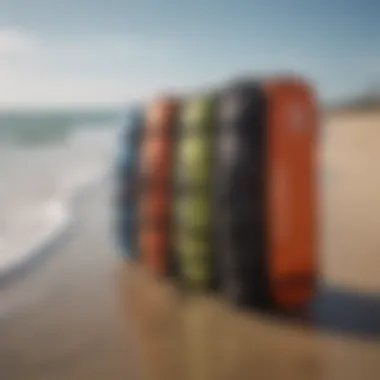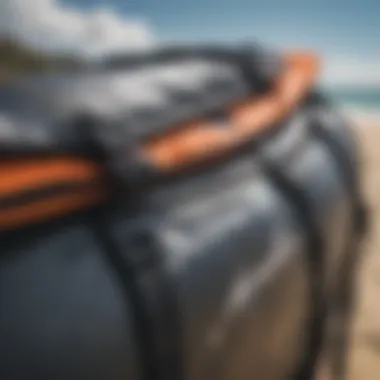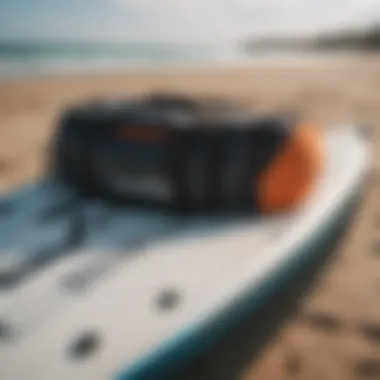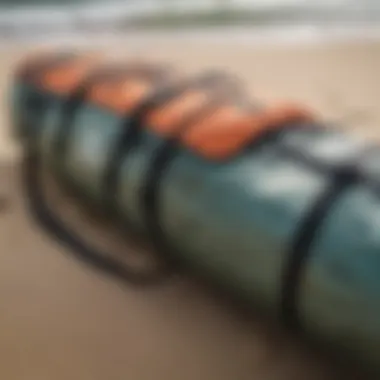Understanding Kitesurf Board Bags: A Comprehensive Guide


Intro
When it comes to kitesurfing, the gear you use plays a pivotal role in your experience on the water. Among the many pieces of equipment that kiteboarders rely on, the kitesurf board bag stands out as an essential accessory. Not only does it protect invaluable gear, but it also simplifies transport and storage. In this guide, we will peel back the layers of kitesurf board bags, examining their types, features, and their significance within the broader kitesurfing community.
Kitesurf board bags come in an array of options, each tailored to different needs and preferences. From the beginner eager to keep their first board in pristine condition, to the seasoned pro that takes their gear around the globe, knowing what bag to pick is crucial. Furthermore, understanding how these bags impact the longevity of your equipment can save kiteboarders both time and money in the long run.
Whether you are hitting the local spot or planning an international kitesurfing adventure, this article will equip you with the knowledge you need to make informed decisions regarding kitesurf board bags. We’ll discuss the best practices, delve into environmental considerations, and even touch on safety, ensuring that you're well prepared for your next session.
Let’s dive in!
Prologue to Kitesurf Board Bags
Kitesurf board bags play a pivotal role in the kiteboarding experience, serving not merely as a vessel for transporting gear but essential for safeguarding the investments made into equipment. A well-chosen board bag can alleviate the stress of traveling while enhancing convenience and efficiency. Whether one is hauling gear across towns or globetrotting, these bags are indispensable allies that keep the equipment safe from the rigors of transport.
The Role of a Board Bag in Kiteboarding
For kiteboarders, the board bag is more than just a protective sheath; it’s a reliable companion during trips to and from the beach. Imagine a scenario where you’re excitedly heading to a new kiteboarding spot. You pack your gear, but then, upon arrival, the board has sustained damage due to careless handling. A quality board bag would have mitigated this worry by buffering impacts and shielded it from potential scratches, dents, or dings.
Moreover, having a dedicated bag allows for organized storage. The equipment becomes easier to manage, removing the chaos of misplacing items or dealing with tangled lines and loose parts. The best board bags often come with compartments designed for kites and other accessories, so everything has its place. This organization isn’t just a convenience; it’s crucial in ensuring that the kiteboarding experience is enjoyable from start to finish.
Why Every Kiteboarder Needs One
The argument for board bags resonates with far too many kiteboarders who’ve learned the hard way about their necessity. From the novice to the pro, everyone can relate to the pain of a damaged board. Investing in a quality board bag often pays for itself by preventing costly repairs or replacements. With fluctuating prices in equipment today, this precaution becomes critical.
Benefits of using a board bag include:
- Protection against elements: UV rays, moisture, and abrasions can all compromise the board's integrity. A sturdy bag minimizes these risks.
- Ease of transport: Kitesurf bags often have wheels and padded straps, making movement smoother than carrying disorganized gear.
- Travel readiness: Many airlines impose strict regulations on sports equipment. A proper bag that fits certain dimensions and protections can help avoid excess fees or outright refusals.
One often overlooked aspect is the attention it draws versus leaving a board unprotected. A kitesurf board bag signals professionalism and care, which, for instructors or event organizers, enhances credibility. In the end, a board bag is a requirement, not just a luxury; it’s essential for anyone committed to this exhilarating sport.
Types of Kitesurf Board Bags
When it comes to kitesurfing, the type of board bag you choose can significantly impact your experience — whether you’re traversing sandy beaches or jet-setting across the globe. Understanding the different types of kitesurf board bags helps ensure that you protect your gear and facilitate ease of travel. Each kind has its unique advantages, making it essential to select one that aligns with your needs.
Soft Shell Bags
Soft shell bags are like the flexible friend in your travel circle. They are crafted from durable materials but maintain a lightweight design that makes them easy to carry. These bags usually feature padded interiors to safeguard against dings and scratches while remaining versatile in terms of storage space.
One of the big draws of soft shell bags is their ability to fit into tight spots. Their pliability means you can often shove one under an airplane seat or in a packed car much easier than a hard shell. Many come equipped with handles and shoulder straps for comfortable transport. But there’s a catch: while they provide decent protection, they may not guard against heavy impacts like a hard shell can.
"A soft shell bag is great for everyday use but consider an additional protection layer for extreme travels."
Hard Shell Bags
On the flip side of the coin is the hard shell bag. This robust option offers maximum protection, making it a favorite among kiteboarders who frequently travel with their gear. Built from a rigid material, hard shell bags are designed to absorb shocks. They’re particularly effective for those long-haul flights where baggage handling can be brutal; they stand up against rough handling during transit.
When considering a hard shell bag, think about the weight it may add. While you’ll have peace of mind knowing your equipment is well protected, the extra bulk can be a burden during your travels. However, they often come with built-in wheels for easy mobility, making them more manageable despite their weight.
Hybrid Options
For those who can’t decide between the two, hybrid bags offer a compromise, combining the features of soft and hard shell bags. These bags typically have a sturdy outer layer that provides excellent protection while remaining lightweight and easy to carry, thanks to their soft shell technology.


Hybrid options can be particularly appealing for kiteboarders who want flexibility without compromising too much on safety. They're designed for versatility; you might find a selection that caters to lighter material needs, while also providing the sturdy armor necessary for protecting your gear. Whether you're hitting a local beach or taking an international trip, these bags can flex to fit your itinerary.
Factors to Consider When Choosing a Board Bag
Choosing the right board bag is not something to be taken lightly; it can make or break your kiteboarding experience. A well-chosen board bag serves not just as a protective shell for your gear but also enhances your overall travel experience. So, before you jump right into a purchase, it’s crucial to keep several factors in mind.
Size and Compatibility
First things first, size is king when it comes to kitesurf board bags. You need to ensure that your bag comfortably accommodates your kiteboard, while leaving space for the bindings. An ill-fitting bag can cause unnecessary wear and tear on your equipment.
Many board bags are designed with specific sizes and shapes. For instance, if you own a twin-tip board, make sure to select a bag that fits that style. It’s also wise to check the dimensions of the bag against your board. Most vendors offer detailed sizing charts online, which can be invaluable. For those who travel frequently, consider a bag that can store multiple boards or has adjustable compartments.
"Selecting a board bag that fits your gear precisely means there’s less chance of your board jostling around during transport, which can save you from expensive repairs."
Padding and Protection Features
Next up is padding. The padding provided by a board bag can vary wildly. Some bags come with barely-there padding that feels more like an afterthought, while others boast multiple layers of dense foam. Opt for bags that offer robust padding if you’re traveling long distances or planning on checking your gear at airports.
Also, look for reinforced corners and padded rails, as these areas are particularly vulnerable during handling and transport. Some bags even include separate compartments for bindings and other accessories, which adds another layer of protection.
Materials and Durability
Finally, let’s talk about materials. The longevity and effectiveness of your board bag greatly depend on the material it's made from. Common materials include nylon and polyester, but not all synthetics are created equal. Look for options that tout UV resistance and waterproof capabilities, especially if you frequent coastal areas or are planning extended trips.
A good board bag should withstand the rigors of travel and the elements, so investing in a durable material can save you headaches in the long run. Pay attention to stitching and zippers as well; heavy-duty zippers can be a game changer when the weather turns foul.
Maintenance and Care for Your Board Bag
Taking care of your kitesurf board bag is a vital aspect of ensuring your kiteboarding experience remains seamless. A well-maintained board bag not only protects your gear but also prolongs its lifespan, making it a sound investment. Regular maintenance can help prevent damage from the elements, such as moisture, sand, and UV exposure, which could compromise the integrity of your equipment.
When you think about it, kitesurfing is an adventure sport that puts your gear through the wringer. From traveling to remote locations to braving churned-up waters, your board bag faces a lot. Thus, investing a little time into its upkeep provides valuable benefits, including:
- Increased longevity: Just like a well-fed dog, a well-cared-for board bag lasts longer.
- Protection against wear and tear: Keeping it clean and stored properly helps fend off damage that comes from regular use.
- Enhanced transport: A clean and well-kept board bag is easier and safer to transport.
In short, maintenance and care for your board bag is not just about keeping it pretty; it’s about ensuring you preserve what matters most.
Cleaning Techniques
Cleaning your kitesurf board bag is arguably one of the most straightforward yet crucial steps in maintenance. The right cleaning technique can save you from having to replace it too often. Here are some effective methods:
- Rinsing with Fresh Water: After a day at the beach, it's essential to rinse out any saltwater and sand. Grab a hose or bucket of freshwater and give your bag a good soak to prevent grime buildup.
- Using a Mild Detergent: For deep-cleaning, you can't go wrong with a mild soap. Mix a bit of detergent with water and scrub the surface gently using a sponge. Avoid using harsh chemicals as they might corrode the material of your bag.
- Spot Cleaning Stains: Got a stubborn stain? Dab it with a cloth and your detergent solution. Blot, don’t rub—this will help keep the fabric intact.
- Drying: Always air-dry your bag after cleaning. Direct sunlight can cause fading, so if possible, let it dry in a shaded area.
Remember: Regular cleaning can prevent the growth of mold and mildew, which can be a real pain to remove.
Storage Recommendations
Where you store your board bag can make a big difference. The right storage conditions will minimize the exposure to harmful elements.
- Keep it Dry: Moisture is the enemy. Make sure your bag is dry before you pack it up for storage. Even tiny remnants of water can cause issues, especially if the bag is stowed away for a while.
- Avoid Improper Folding: Instead of cramming your board bag into a tight space, it’s better to hang it or lay it flat. This helps to maintain its shape and prevents creasing.
- Store in a Cool Place: Try to keep your bag away from direct sunlight and extreme temperatures. High heat can lead to degradation of materials over time, making them weak and brittle.
- Check for Pests: If you’re in a location with insects, ensure your bag does not attract unwanted critters. Occasionally, give it a once-over to make sure it’s pest-free.
Traveling with a Kitesurf Board Bag
Traveling with a kitesurf board bag is not just a matter of convenience; it plays a crucial role in ensuring that your gear arrives safely at your destination. Whether you're heading to a tropical paradise or a local bay, understanding the nuances of transporting your equipment can make all the difference. After all, the last thing you want is to arrive and find your kiteboard has been damaged or your accessories lost in transit. So, let's break down the key elements that come into play when you’re gearing up for a trip.


Airline Regulations and Fees
Airlines can be sticklers for rules when it comes to kitesurfing gear. Each airline has its own set of regulations regarding the transport of sporting equipment, which often include additional fees. A good practice is to check the airline’s website before you book your ticket, as policies can vary significantly.
Before you head to the airport, consider the following:
- Size Limits: Most airlines have strict dimensions for checked luggage, including board bags. It's best to measure your bag and see how its dimensions stack up against the airline's limits. If your board bag is larger, be prepared to pay excess baggage fees, which can be quite steep.
- Weight Restrictions: The standard weight limit for checked luggage usually hovers around 50 pounds. If your bag is over this, it might cost you an extra penny. Weigh your bag at home to avoid unpleasant surprises at the check-in counter.
- Fees: Many airlines charge extra for sporting equipment, which can range from $50 to $150. Some may even consider your board bag a separate piece of luggage. Prior knowledge can save you bucks and headaches at the airport.
Remember, it’s not just about the cost; it’s about understanding the logistics of traveling with your board bag. Familiarizing yourself with these rules ahead of time can significantly diminish the stress of last-minute packing and possible delays.
Best Practices for Safe Transport
Once you’ve nailed down the airline regulations, it’s time to think about how to keep your gear safe during transport. A little thoughtfulness goes a long way. Here are some best practices:
- Use Proper Padding: Ensure that your board is well-protected inside the bag. Many high-quality board bags come with extra padding or compartments for accessories. Don’t skimp on these features—protection is key.
- Pack Smartly: Store smaller items like fins, a leash, and other essentials in separate inner compartments or in pockets. This not only helps you stay organized but also offers extra cushioning for your board.
- Label Your Bag: It may sound basic, but labeling your bag can help in case it gets misplaced. Use tags that feature your name, address, and contact information, and consider adding a unique identifier or color to make your bag stand out.
- Secure Everything: If your bag has compression straps or zippers, use them. Make sure everything inside is tightly secured. This prevents your gear from shifting around, which can lead to damage.
- Stay Aware at Security Checkpoints: Be prepared to unpack parts of your board bag if asked. Security personnel may want to inspect the contents, so having everything organized and easily accessible can save you time and prevent any hassle.
"A well-packed kitesurf board bag is the difference between fun days on the water and frustration caused by damaged gear!"
By following these best practices, you not only ensure the safety of your equipment but also your peace of mind as you navigate the often chaotic airport environment. Packing efficiently and understanding your airline’s requirements can transform an otherwise stressful experience into a smooth journey. Happy travels!
Popular Brands and Market Trends
When it comes to selecting a kitesurf board bag, understanding the dynamics of leading brands and current market trends is crucial. The right bag not only safeguards your valuable gear but can also enhance your experience on the water, ensuring you can focus on having a blast without worrying about damaged equipment.
Recognizing top brands gives kiteboarders insight into reliability and quality. Established names often set high standards for design and durability, making their products a safe bet for anyone serious about the sport. However, as trends shift, there are new entrants looking to shake things up, often bringing fresh ideas and innovative features to the table. This section will delve into both well-known manufacturers and the rising stars in the industry.
Leading Brands in Board Bags
Several key players have consistently maintained a reputation for producing high-quality kitesurf board bags. Brands like Dakine, Prolimit, and North Kiteboarding have, over the years, proven to create reliable gear that kiteboarders trust. Here are some aspects that elevate these brands:
- Dakine: Known for their durable materials and thoughtful design, Dakine bags often boast reinforced stitching and ample padding. This ensures that boards are snug and secure during transport, minimizing the risk of damage.
- Prolimit: They emphasize not just protection but also usability. For instance, many Prolimit bags come equipped with ergonomic straps that make lugging them around a more comfortable affair.
- North Kiteboarding: This brand has been pushing the envelope with high-performance bags that are both lightweight and resilient. Their designs reflect an in-depth understanding of the needs of kiteboarders, making them a preferred choice for professionals.
Beyond traditional names, newer brands are emerging, which appeal to those looking for unique features or eco-friendly materials. Keeping an eye on these shifts can offer kiteboarders additional options that might address specific needs or preferences.
Emerging Innovations in Design and Materials
The kitesurf board bag industry is not static. In fact, it's experiencing a wave of innovation that caters to both performance and sustainability. Here are some notable trends:
- Lightweight Yet Protective: Manufacturers are experimenting with lightweight materials that sacrifice neither weight nor protection. Some bags use advanced fabrics like ripstop nylon, offering excellent tear resistance without the bulk.
- Eco-Conscious Production: There's a growing awareness about the environment among kiteboarders. Brands are responding by incorporating recycled materials or sustainable practices into their manufacturing processes. This shift not only appeals to eco-minded individuals but also sets a bar for industry standards.
- Customizable Features: More brands are allowing boarders to customize bags with multiple compartments or adjustable padding. This adaptability can be particularly beneficial for kiteboarders who carry various gear.
In summary, knowing the leading brands and keeping an eye on emerging materials and design trends can profoundly impact your kitesurfing experience. Each element, from the bag's weight to its environmental footprint, plays a role in shaping how you interact with the water and your gear. > "A well-chosen board bag is not just about carrying your gear; it's about elevating your kiteboarding journey."
Understanding these trends not only prepares you better as a consumer but also enhances your appreciation for the craftsmanship behind each bag. As innovations continue to transform the landscape, kiteboarders have more options than ever to protect their investments.
Environmental Considerations
When it comes to kitesurfing, protecting the environment often gets overlooked. The use of kitesurf board bags isn't just about protecting your gear. It's also about being mindful of the materials and processes that go into their production. In today's world, where ecological concerns are on everyone’s lips, understanding the environmental considerations related to kitesurf board bags can make a real difference.
Using eco-friendly materials and sustainable practices not only helps in reducing the ecological footprint of the sport, but it also influences consumer choices and brand reputations. Kiteboarders are increasingly seeking products that align with their values. Engaging in environmentally conscious practices can also drive the industry toward a greener future.
Eco-Friendly Materials in Production


The choice of materials in kitesurf board bags is crucial. Traditional materials often involve harmful chemicals and processes that can weigh heavy on our planet's health. However, there's a shift happening. Many brands are now prioritizing the use of recycled plastics, organic cotton, and biodegradable options.
- Recycled Plastics: These materials help decrease waste. They reduce the reliance on virgin oil products and lessen the demand for unsustainable practices.
- Organic Cotton: Cotton grown without hazardous pesticides is not just eco-friendly; it's also better for our skin. This is a win for both consumers and the environment.
- Biodegradable Options: Some manufacturers are venturing into using materials that break down naturally over time, significantly cutting down on landfill contributions.
By opting for bags made from these materials, kiteboarders don’t just protect their own gear—they also contribute to the larger picture of sustainability in their sport.
"Choosing a kitesurf board bag made of eco-friendly materials is a commitment to the environment. It's a small change that can create ripples across the industry."
Sustainable Practices in the Kiteboarding Industry
Sustainability isn't merely about the materials used; it's also about how products are made, packaged, and distributed. The kiteboarding industry is slowly but surely waking up to the need for sustainable practices.
- Local Sourcing: Many companies are now sourcing materials locally. This not only supports local economies but also reduces transportation emissions—an important factor considering the shipping footprint.
- Fair Labor Practices: Ethical manufacturing processes ensure that workers are treated fairly. This approach brings a sense of responsibility and transparency that customers appreciate.
- End-of-Life Programs: Some brands now offer programs for recycling their products once they reach the end of their life cycle. This step can significantly lessen waste and encourage a circular economy.
By supporting brands that champion sustainable practices, kiteboarders can play a crucial role in pushing the industry toward a more environmentally friendly direction. The road to sustainability may have few bumps, but together, the community can steer it to a greener destination.
Safety Aspects of Kitesurf Board Bags
When it comes to kitesurfing, the thrill of catching waves and soaring through the air often takes center stage. However, behind those exhilarating moments lies a critical component—safety. In the realm of gear, this includes one’s board bag. Selecting a kitesurf board bag with proper safety features can significantly impact how well your equipment endures the ride. Understanding the facets of safety surrounding board bags ensures that your investment remains intact and functional, reinforcing the importance of this often-overlooked aspect of kitesurfing.
Ensuring Proper Padding
Proper padding is like a good cushion that keeps you comfy; it's a non-negotiable when it comes to kitesurf board bags. Board bags with adequate padding not only protect the board from dings and scratches that can occur during transport but also absorb impacts that might happen when you’re on the move or while the bag is being handled. Generally, it is advisable to look for bags that feature high-density foam padding, as it offers better shock absorption as opposed to lower-quality materials.
Additionally, reinforced corners and edges provide extra protection, ensuring that the most vulnerable parts of the board are shielded from potential damage.
Some tips include:
- Check Padding Thickness: Look for bags with at least 10mm of padding for effective impact protection.
- Inspect Inner Lining: A soft inner lining can prevent scratches on your board’s surface.
- Consider Bag Design: Bags designed with multiple compartments can help secure the board snugly, reducing movement and potential impact.
"Choosing the right board bag does more than just protect your gear; it safeguards your sporting passion."
Accidents and Incidents
Accidents happen, and when they do, being prepared can make all the difference. Knowing how to mitigate risks associated with board bags is essential for both novice and experienced kiteboarders. For instance, many kiteboarders underestimate the risks posed by heavy-duty travel, where bags are dragged through airports or tossed around by baggage handlers. In such scenarios, a poorly designed bag can easily lead to damage of the board or even an injury to oneself when lifting an awkwardly shaped bag.
To avoid such mishaps, consider the following:
- Weight Distribution: Make sure your board is positioned well within the bag to balance its weight.
- Use Extra Straps: Many bags come with exterior straps or buckles that can secure contents, minimizing the chance of accidents.
- Educate Yourself: Familiarize yourself with your airline’s baggage policies to avoid unexpected incidents due to size or weight limits.
Investing in a quality bag can be the difference between preserving your kitesurfing gear and needing costly repairs after an accident. Therefore, ensuring proper padding and understanding the risks associated with transporting your board are fundamental in enhancing your safety on the water and during travels.
The End
In the world of kitesurfing, the right board bag often goes unnoticed. Yet, as this comprehensive guide has illustrated, these bags play a pivotal role in both the protection of gear and the convenience of transport. A well-chosen bag can make the difference between a smooth traveling experience and unnecessary hassle.
Summarizing Key Takeaways
Throughout this article, we touched upon various aspects that underline the significance of kitesurf board bags:
- Protection: Board bags help shield your valuable equipment from the elements and any potential damage. The right padding can absorb shocks from unexpected drops, which is crucial when handling gear.
- Types of Bags: Understanding the differences between soft shell, hard shell, and hybrid options allows you to make an informed decision based on your needs and travel style. Each has its unique advantages, fitting different situations.
- Selection Factors: Size, compatibility, and material matter significantly when picking a bag. A mismatch in size can render your bag useless, while durable materials ensure the longevity of your investment.
- Maintenance: Proper care keeps your board bag in good shape longer. Cleaning and correct storage prevent mildew and wear, saving you from potential replacement costs down the road.
- Travel Considerations: Awareness of airline regulations and prudent packing can avert frustrations during trips, ensuring your gear arrives safely and intact.
- Environmental Responsibility: Opting for eco-friendly materials demonstrates a commitment to sustainability, which resonates with many kiteboarders today.
Looking Ahead at Kitesurf Board Bag Developments
As kiteboarding technology evolves, so do the designs and materials used in board bags. The future holds exciting possibilities:
- Innovative Materials: We may soon see board bags made from advanced, lightweight, yet durable fabrics. Such materials promise to enhance protection without compromising portability, paving the way for easier travel.
- Smart Features: Imagine bags equipped with GPS tracking, or built-in cooling systems to protect against high temperatures. With rapid advancements in technology, these features may soon become the norm.
- Sustainability Focus: The industry is increasingly leaning towards ecological responsibility. Expect more brands to adopt sustainable practices, using recycled materials and minimizing waste.
In summary, as the kiteboarding landscape continues to grow and diversify, staying informed about kitesurf board bags equips enthusiasts with critical knowledge. This insight not only enhances personal experience but also contributes positively to the kiteboarding community. Armed with these takeaways, kiteboarders can select the best board bag tailored to their adventure needs.















